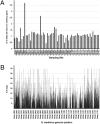Nitrosopumilus maritimus genome reveals unique mechanisms for nitrification and autotrophy in globally distributed marine crenarchaea
- PMID: 20421470
- PMCID: PMC2889351
- DOI: 10.1073/pnas.0913533107
Nitrosopumilus maritimus genome reveals unique mechanisms for nitrification and autotrophy in globally distributed marine crenarchaea
Abstract
Ammonia-oxidizing archaea are ubiquitous in marine and terrestrial environments and now thought to be significant contributors to carbon and nitrogen cycling. The isolation of Candidatus "Nitrosopumilus maritimus" strain SCM1 provided the opportunity for linking its chemolithotrophic physiology with a genomic inventory of the globally distributed archaea. Here we report the 1,645,259-bp closed genome of strain SCM1, revealing highly copper-dependent systems for ammonia oxidation and electron transport that are distinctly different from known ammonia-oxidizing bacteria. Consistent with in situ isotopic studies of marine archaea, the genome sequence indicates N. maritimus grows autotrophically using a variant of the 3-hydroxypropionate/4-hydroxybutryrate pathway for carbon assimilation, while maintaining limited capacity for assimilation of organic carbon. This unique instance of archaeal biosynthesis of the osmoprotectant ectoine and an unprecedented enrichment of multicopper oxidases, thioredoxin-like proteins, and transcriptional regulators points to an organism responsive to environmental cues and adapted to handling reactive copper and nitrogen species that likely derive from its distinctive biochemistry. The conservation of N. maritimus gene content and organization within marine metagenomes indicates that the unique physiology of these specialized oligophiles may play a significant role in the biogeochemical cycles of carbon and nitrogen.
Conflict of interest statement
The authors declare no conflict of interest.
Figures



References
-
- Karner MB, DeLong EF, Karl DM. Archaeal dominance in the mesopelagic zone of the Pacific Ocean. Nature. 2001;409:507–510. - PubMed
-
- Agogué H, Brink M, Dinasquet J, Herndl GJ. Major gradients in putatively nitrifying and non-nitrifying Archaea in the deep North Atlantic. Nature. 2008;456:788–791. - PubMed
-
- Fuhrman JA, McCallum K, Davis AA. Novel major archaebacterial group from marine plankton. Nature. 1992;356:148–149. - PubMed
-
- Venter JC, et al. Environmental genome shotgun sequencing of the Sargasso Sea. Science. 2004;304:66–74. - PubMed
Publication types
MeSH terms
Substances
Grants and funding
LinkOut - more resources
Full Text Sources
Other Literature Sources
Molecular Biology Databases

